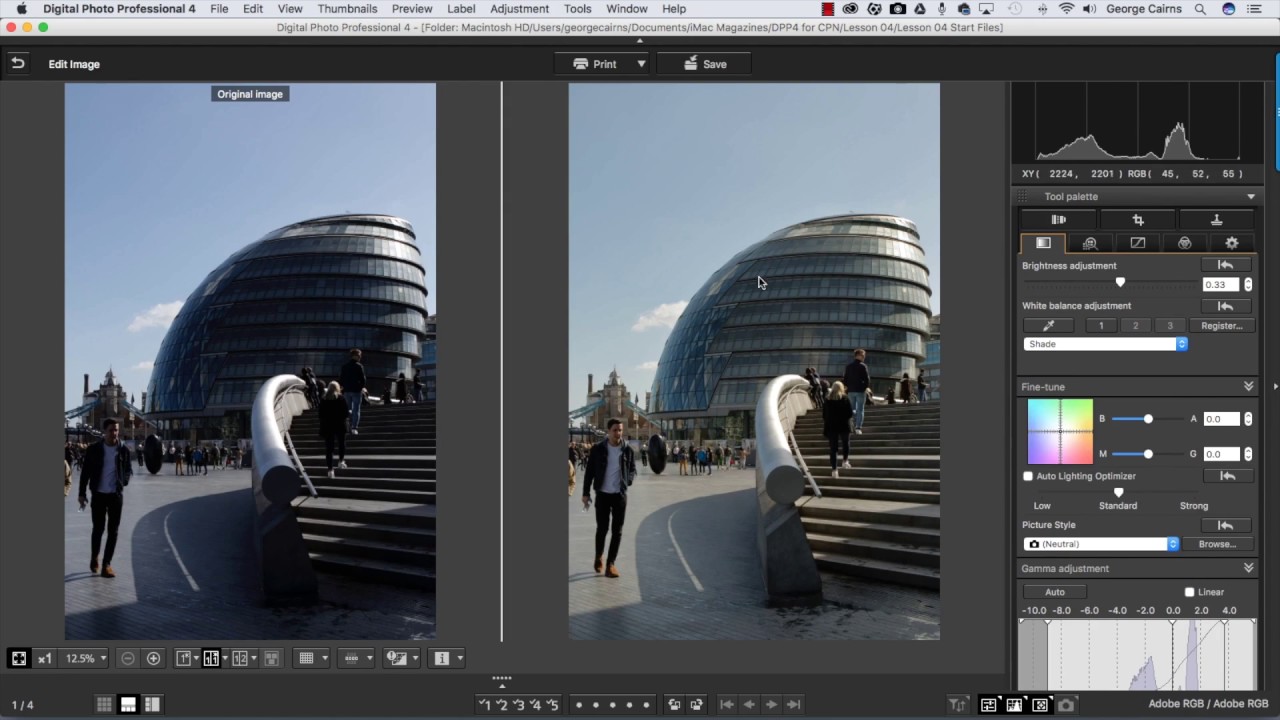Introduction
Welcome to the world of digital photography! Whether you’re new to photography or looking to enhance your skills, this article will guide you through the steps of capturing stunning digital photos. With the advancement of technology, taking high-quality images has become more accessible than ever before. From selecting the right camera to mastering composition and lighting, and diving into the wonders of photo editing, we will cover all the essentials.
In today’s digital age, photography has become an integral part of our lives. We use our smartphones to capture everyday moments, share them on social media, and immortalize memories. However, if you truly want to take your photography to the next level, investing in a dedicated digital camera is crucial. These cameras offer more versatility, control, and superior image quality.
Now that you have your camera, it’s time to delve into the fundamentals of composition. Composition refers to how elements are arranged within the frame to create visually appealing and balanced images. Understanding concepts such as the rule of thirds, leading lines, and framing will help you compose captivating photographs that draw the viewer’s eye.
Alongside composition, mastering lighting techniques is vital to create visually striking images. The right lighting can completely transform a photograph, setting the mood and highlighting the subject. Learn to identify different types of light, experiment with natural and artificial sources, and understand how to control exposure for optimal results.
While many digital cameras have automatic settings, taking control of the manual settings will give you more creative freedom. Familiarize yourself with shutter speed, aperture, and ISO, and learn how these settings can be adjusted to achieve specific effects. Get comfortable with shooting in different modes, such as aperture priority, shutter priority, and manual, to fully explore your camera’s capabilities.
Step 1: Choose the Right Camera
When it comes to digital photography, selecting the right camera is essential. The market is flooded with numerous options, ranging from compact cameras to advanced DSLRs. Consider the following factors to make an informed decision on the camera that suits your needs:
- Camera Type: Decide whether you prefer a compact point-and-shoot camera for convenience or a more professional DSLR for greater control and versatility.
- Megapixel Count: Higher megapixel count doesn’t always guarantee better image quality. Consider your intended use to determine the ideal megapixel range for your camera.
- Image Sensor: A larger sensor size generally produces better image quality, especially in low-light conditions. Full-frame sensors are preferred by professionals, while cropped sensors are more common in entry-level DSLRs.
- Lens Compatibility: If you plan on upgrading your lens collection in the future, ensure that the camera you choose has a wide range of compatible lenses available.
- Features and Controls: Look for features like image stabilization, autofocus performance, customizable controls, and the ability to shoot in RAW format for greater post-processing flexibility.
- Budget: Consider your budget and determine the best camera that offers the features you need within your price range.
Keep in mind that the camera is just a tool; the photographer’s skills and creativity play a crucial role in capturing remarkable photographs. Therefore, choose a camera that you feel comfortable with and will motivate you to explore and experiment with your photography.
Step 2: Understand the Basics of Composition
Composition is the art of arranging elements within a photograph to create visually pleasing and impactful images. By understanding the basics of composition, you can take your photography from ordinary to extraordinary. Here are some fundamental principles to consider:
- Rule of Thirds: Imagine dividing your frame into thirds both horizontally and vertically, forming a grid of nine equal sections. Place your main subject or points of interest along the lines or at the intersections. This technique adds balance and visual interest to your composition.
- Leading Lines: Incorporate lines that lead the viewer’s eye into the image. These lines can be anything from roads, pathways, or even natural elements like rivers or tree branches. Leading lines create depth, guide the viewer’s gaze, and add a sense of movement to the photo.
- Symmetry and Patterns: Symmetrical compositions create a sense of harmony and balance. Look for symmetrical elements in your surroundings, such as buildings, bridges, or reflections in water. Patterns, on the other hand, are repetitive elements that can add visual interest and texture to your photos.
- Foreground and Background: Pay attention to the foreground and background elements to create depth and dimension in your composition. Use objects or people in the foreground to add a sense of scale or frame the main subject.
- Texture and Detail: Capture the texture and fine details of your subject to add visual interest and create a more engaging photograph. This can be achieved by getting closer to your subject and using techniques like macro photography.
- Negative Space: Don’t be afraid of empty spaces in your composition. Utilize negative space to bring emphasis to your main subject and create a sense of simplicity and minimalism in your photographs.
Remember, these composition principles are not strict rules, but rather guidelines to help you create visually appealing photos. Experiment, trust your creative instincts, and don’t be afraid to break the rules occasionally to create unique and captivating images.
Step 3: Master Lighting Techniques
Lighting is a crucial aspect of photography, as it can make or break your images. Understanding how different lighting conditions affect your subject and learning to control light will greatly enhance the quality of your photographs. Here are some essential lighting techniques to master:
- Natural Light: Take advantage of natural light, especially during the golden hours – the hour after sunrise and the hour before sunset. The soft, warm light during these times creates a beautiful, flattering glow. Avoid harsh midday sunlight, as it can create unappealing shadows and high contrast.
- Diffused Light: If shooting in direct sunlight, look for ways to diffuse the light to create a softer and more pleasing effect. Use a diffuser, shoot in the shade, or wait for a cloudy day when the clouds act as a natural diffuser.
- Backlighting: Experiment with backlighting by positioning your subject in front of a strong light source, such as the sun. This creates a dramatic effect with a beautiful halo of light around the subject. Be careful to expose for the subject to avoid silhouettes.
- Artificial Light: Explore using flash, reflectors, and artificial lighting sources, such as studio lights or speedlights, for more control over your lighting. Experiment with different angles, distances, and intensities to achieve the desired effect.
- Lighting Ratios: Understand the concept of lighting ratios and how they can help you control the balance between light and shadow in your photographs. Different lighting ratios can create various moods and emphasize certain features of your subject.
- White Balance: Pay attention to white balance to ensure accurate color representation in your photos. Use the appropriate white balance settings on your camera or adjust it during post-processing to match the lighting conditions.
Mastering lighting techniques takes time and practice. Observe and study how light interacts with your subject in different settings. Experiment with different lighting techniques and understand how they can enhance your images. Don’t be afraid to make mistakes and learn from them to develop your own unique lighting style.
Step 4: Adjust Camera Settings
Adjusting camera settings allows you to have full control over your photography. While modern digital cameras offer automatic modes, understanding and utilizing manual settings will elevate your images to new heights. Here are some key camera settings to explore:
- Shutter Speed: Shutter speed determines the amount of time your camera’s shutter remains open. Faster shutter speeds freeze motion, while slower speeds create motion blur. Experiment with different shutter speeds to capture action or create artistic effects.
- Aperture: Aperture refers to the opening in the lens that controls the amount of light entering the camera. It also affects the depth of field, or the range of the image that appears in sharp focus. Play with wider apertures (lower f-stop values) for a shallow depth of field with a blurred background.
- ISO: ISO measures the sensitivity of your camera’s image sensor to light. Lower ISO settings are ideal for well-lit situations, while higher ISO values are used in low light conditions. Keep in mind that higher ISOs can introduce noise or grain in your images.
- Exposure Compensation: Use exposure compensation to adjust the overall brightness of your image when shooting in semi-automatic or automatic modes. Increase exposure compensation to make the image brighter or decrease it for a darker result.
- White Balance: White balance affects the color temperature in your photos. Adjust the white balance setting to match the lighting conditions and capture accurate colors. Experiment with different white balance presets or use a custom white balance setting.
- Focus Mode: Choose between manual and autofocus modes depending on your subject and shooting conditions. Autofocus offers convenience, while manual focus provides more control and precision.
By understanding and utilizing these camera settings, you can adapt to different shooting scenarios and creatively capture your vision. Take the time to experiment with the various settings and observe how they affect the outcome of your photos. Adjusting camera settings will allow you to have complete control over the exposure, depth of field, and overall look of your images.
Step 5: Learn Photo Editing
Photo editing plays a vital role in enhancing and fine-tuning your digital photos. With the wide array of editing software available, mastering photo editing techniques will take your images to the next level. Here are some key aspects of photo editing to explore:
- Adjusting Exposure and Contrast: Use exposure and contrast adjustments to correct the overall brightness and enhance the dynamic range of your photos. This helps bring out details in the shadows and highlights.
- Color Correction: Adjust the color balance, saturation, and vibrance to achieve the desired color rendition in your images. Correct any color cast or make creative color toning choices to set the mood.
- Sharpening and Noise Reduction: Use sharpening techniques to enhance the clarity and details in your photos. Apply noise reduction to reduce the unwanted grain or noise that can occur, especially in higher ISO images.
- Cropping and Straightening: Use cropping and straightening tools to improve the composition and remove any distracting elements from the frame. This helps to focus the viewer’s attention on the main subject.
- Retouching and Spot Healing: Utilize retouching tools to remove blemishes, wrinkles, or unwanted objects from your images. Spot healing tools can help you eliminate distracting spots or dust in your photos.
- Filters and Presets: Experiment with filters and presets to create unique artistic effects or quickly enhance the mood of your images. These pre-defined settings can be a great starting point for your editing process.
- Non-Destructive Editing: Work with editing software that supports non-destructive editing, where your original image remains untouched. This allows you to make changes and experiment without permanently altering the original file.
Learning photo editing is a continuous process, and there are countless resources available online that offer tutorials and tips for various editing software. Experiment with different editing techniques, develop your own editing style, and don’t be afraid to push boundaries to bring your creative vision to life.
Step 6: Practice, Practice, Practice
Practice is the key to improving your photography skills. As with any art form, the more you practice, the more you’ll learn, grow, and develop your unique style. Here are some tips to enhance your photography practice:
- Shoot Regularly: Make it a habit to bring your camera with you wherever you go and capture moments that catch your eye. The more you shoot, the more opportunities you have to experiment with composition, lighting, and different subjects.
- Explore Different Locations: Step out of your comfort zone and explore different environments and settings. Whether it’s a bustling cityscape, a serene natural landscape, or a charismatic street scene, each location offers unique photographic opportunities.
- Experiment with Different Genres: Don’t limit yourself to one genre of photography. Try your hand at landscapes, portraits, macro, street photography, or any other genre that piques your interest. This helps you discover new perspectives and develop diverse skills.
- Learn from Others: Take inspiration from other photographers. Study their work, read books and articles, attend workshops or photography classes, and engage with the photography community. Exchange ideas and learn from the experiences of fellow photographers.
- Seek Feedback: Share your work with others and actively seek constructive feedback. Feedback from fellow photographers or online photography communities can provide valuable insights and help you identify areas for improvement.
- Review and Critique your Own Work: Set aside time to review your own photos critically. Analyze what works and what doesn’t, identify your strengths and weaknesses, and reflect on how you can improve your techniques and compositions.
- Push your Boundaries: Don’t be afraid to try new techniques, experiment with different camera settings, or challenge yourself creatively. Stepping outside of your comfort zone and taking risks can lead to breakthroughs and unique images.
Remember, the more you practice, the more you’ll refine your photography skills and develop your artistic eye. Embrace both successful shots and those that may not meet your expectations – they are all part of the learning process. Photography is a journey, and through consistent practice, you’ll continually evolve as a photographer.
Conclusion
Congratulations! You’ve now been introduced to the essential steps for making digital photos that truly stand out. By choosing the right camera, understanding composition, mastering lighting techniques, adjusting camera settings, learning photo editing, and practicing consistently, you’re well on your way to honing your photography skills.
Photography is a wonderful blend of art and technology, allowing you to capture moments, express your creativity, and share your unique perspective with the world. Remember, the camera is just a tool, and the real magic lies in your vision and ability to see the beauty in the world around you.
Continue to explore new techniques, experiment with different subjects and genres, and challenge yourself to think outside the box. Embrace the learning process and the inevitable mistakes along the way, as they provide opportunities for growth and improvement.
Don’t forget to seek inspiration from other photographers, learn from their experiences, and share your work with others to gain valuable feedback. Photography is also a journey of self-expression, so allow your images to reflect your personality, emotions, and unique perspective.
So go out there, capture beautiful moments, and let your creativity soar. With passion, practice, and an open mind, you’ll continue to evolve as a photographer and create images that inspire and evoke emotions in viewers. Happy shooting!

























